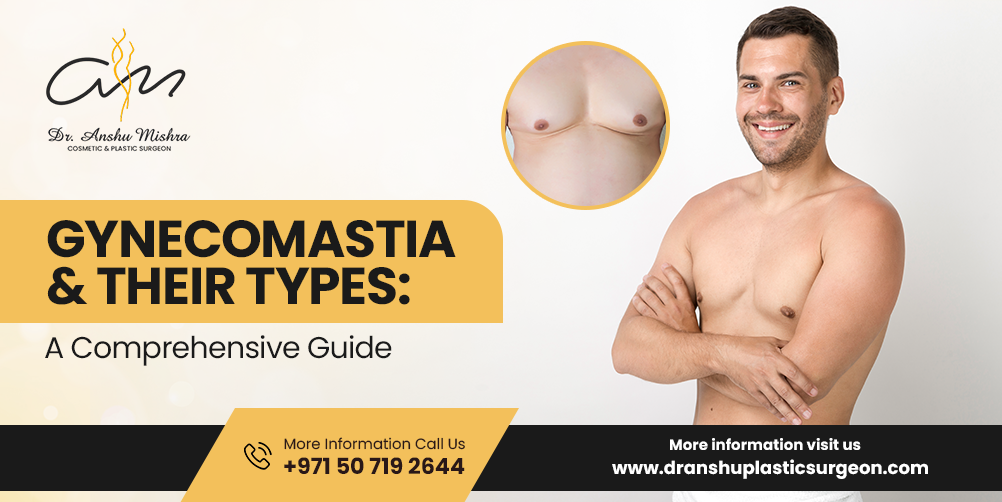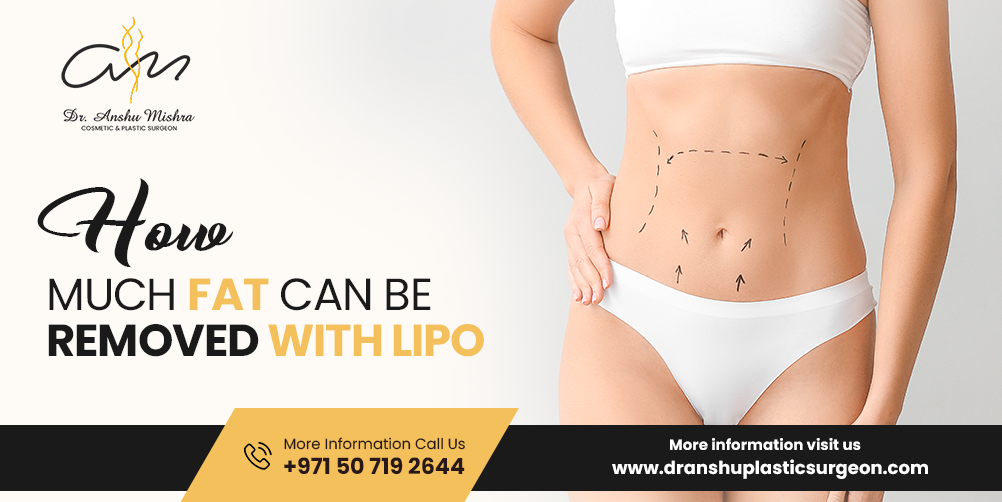The term gynecomastia describes men with enlarged glandular tissue and fatty deposit in the chest that mimics the appearance of female breasts. The degree of enlargement can vary from puffy nipples to pronouncedly larger breasts that resemble a woman’s. The condition is categorized into different types of gynecomastia, based on the severity. Gynecomastia in males can affect one or both sides of the chest, but most cases are bilateral. Surgery may be utilized in some cases to remove excess skin and enhance the areola’s size and location.
Table of Contents
ToggleDifferent Grades of Gynecomastia
Male breast tissue growth is categorized into different types of gynecomastia according to the degree of tissue (gland) development and skin excess. This categorization aids in condition assessment and the development of effective management plans. The amount of glandular enlargement and the existence of extra skin are the two main factors taken into account by the grading system.
Type 1: Mild Gynecomastia
- Little, restricted growth encircles the areola. The breast growth is hardly evident beneath clothes, and there is no loose skin.
- The glandular tissue gives the impression of a little button since it is restricted to the region underneath the areola and results in puffiness of the nipple .
Type 2A: Moderate Gynecomastia without Excessive Skin
- Mild enlargement that protrudes past the areola and forms a mound that melds into the chest. There is no extra skin.
- Compared to gyno type 1, the breast tissue is more noticeable, but the skin is still elastic enough to support the extra volume without drooping.
Type 2B: Moderate Gynecomastia with Minor Excess Skin
- An obvious breast tissue growth that is moderate in size and extends past the areola. There is a tiny amount of extra skin, which might lead to modest sagging.
- The breast becomes more of a mound, and the small amount of extra skin may or may not be required to be surgically corrected.
Type 3: Severe Gynecomastia with Excess Skin
- Markedly enlarged breasts that seem feminized. The tissue grows well beyond the boundaries of areola.
- Because of the thick breast tissue and more skin, the drooping is more noticeable.
- This gyno type frequently mimics a woman’s breasts and may need more extensive surgery to remove extra skin and tissue.
Medical practitioners must comprehend different types of gynecomastia to properly diagnose the condition and choose the most appropriate course of action.
Also Read: Gynecomastia Pinch Test & How To Perform It At Home
Symptoms Of Different Types Of Gynecomastia
The main symptoms, regardless of the types of gynecomastia, are often identical since they all include an expansion of the breast tissue. Nevertheless, depending on the kind, these symptoms may differ in intensity and scope. Here’s a method for categorizing symptoms that takes into account the different types of gyno:
Common Symptoms Across All Types
- All types of gynecomastiahave some degree of breast tissue enlargement, although not all of them.
- Breast region sensitivity or discomfort can be slight to intense.
- All kinds feel a stiff, rubbery mass beneath the nipple region.
Symptoms Differentiation By Type
Type 1
- Mild Gynecomastia: The areola region is the only area of enlargement.
- Breast tissue that is hardly detectable and can be more obvious in the open.
Type 2A
- Gynecomastia in Moderation with No Excess Skin:
- Beyond the areola, enlargement forms a more pronounced breast mound.
- Without producing drooping, the breast tissue melds in with the surrounding chest region.
Type 2B
- Mild Excess Skin and Moderate Gynecomastia
- more noticeable growth accompanied by some skin drooping.
- a noticeable lump on the breasts that is slightly sagging because of some little surplus skin.
Type 3
- Severe Gynecomastia with Excess Skin: This condition involves a noticeable increase in breast tissue along with a large amount of extra skin.
- pronounced sagging that gives the breasts a feminised aspect that is apparent even when clothes are worn.
Treatment of Different Types of Gynecomastia
Gynecomastia is treated differently based on the categorization of different types of gyno, the amount of extra skin present and its severity.
Type 1
To decrease fat deposition, treatment usually entails lifestyle modifications including weight loss and exercise. Medication to correct hormonal abnormalities may be recommended if required. Liposuction is sometimes done to remove glandular tissue and localized fat around the areola. In some cases ,only gland excision can yield good results.
Type 2A
Surgical intervention is frequently necessary for this kind. Often, liposuction is used to remove extra fatty and glandular tissue is also excised . Since the skin naturally retracts, skin removal is typically not necessary.
Type 2B
The main course of therapy is surgery, which includes both excision and liposuction. To obtain an even, natural chest shape, extra fatty tissue and fat are eliminated, and little skin tightening treatments could be required.
Type 3
A more involved surgical strategy is needed for this type. To address the feminised breast look, liposuction, glandular tissue removal, and substantial skin removal are required. The goal of the treatment is to restore a manly chest shape, which may entail moving the nipple to a more natural position.
To get the greatest results, every treatment plan is customised for the patient, taking into account the particular gyno type and degree of gynecomastia.
Also Read: Is Gynecomastia Surgery Painful
Why Choose Dr. Anshu Mishra For Gynecomastia Surgery
There are several benefits to choosing Dr. Anshu Mishra for gynecomastia surgery. With a focus on different types of gynecomastia, Dr. Mishra’s vast experience and patient-centred methodology provide customised treatment programmes for every patient. She prioritises patient safety ,while using cutting-edge surgical procedures to create outcomes that seem natural.
Patients seeking gynecomastia treatment are given confidence by Dr Mishra’s reputation for expertise in cosmetic surgery and her sympathetic care. Patients who choose Dr, Anshu Mishra may anticipate outstanding results, individualized care, and a journey of assistance towards reaching their chosen aesthetic objectives.
Summary
Male breast tissue enlargement, known as gynecomastia, imitates the look of feminine breasts. It might range from bigger, more feminine breasts to puffy nipples. Based on the severity,this condition is divided into different types, which helps with diagnosis and therapy planning. In certain cases, surgery may be required to reposition the areola and remove extra skin. Comprehending the types of gynecomastia is essential for precise diagnosis and efficient handling. Gynecomastia patients have exceptional outcomes from Dr. Anshu Mishra’s competent care and personalised therapy.
FAQs
-
What is the cause of male gynecomastia?
The primary cause of gynaecomastia is an imbalance in the hormones testosterone and oestrogen. Gynaecomastia can be brought on by several factors, including puberty, ageing, pharmaceuticals (such as antidepressants, anabolic steroids, or testosterone), substance misuse (alcohol or narcotics), certain medical problems (such as renal failure or hyperthyroidism), and even fat. The syndrome is caused by overproduction or greater sensitivity to oestrogen, which encourages breast tissue development.
-
Who is most at risk for gynecomastia, and is it common?
Approximately 50–60% of teenage boys get gynecomastia as a result of the hormonal changes associated with puberty. Because testosterone levels normally decrease with age, it can also affect older males. Mother oestrogen can cause temporary gynecomastia in infants. Men are also more likely to acquire this condition if they are overweight or use specific drugs. It may be a transient problem, but if it continues, a medical checkup is advised.
-
What distinguishes gynaecomastia from pseudogynecomastia?
Gynaecomastia is the expansion of glandular and fatty tissue in the male breasts brought on by hormonal abnormalities. Pseudogynecomastia, on the other hand, results from fat buildup alone—a glandular enlargement is not involved. Pseudogynecomastia is common in overweight or obese men and may be treated with weight reduction and exercise, whereas gynecomastia may require medical therapy or surgery to address glandular tissue.
-
Is it possible to avoid gynaecomastia?
While gynecomastia cannot be avoided entirely, some lifestyle changes can help to lower the risk. Gynaecomastia can be avoided by maintaining a healthy weight, abstaining from anabolic steroids, consuming less alcohol, and abstaining from narcotics like marijuana. These actions can help correct hormonal imbalances. It’s also a good idea to check drugs that may induce gynecomastia under a doctor’s supervision.
-
How may gynecomastia affect a man’s mental health?
Gynaecomastia can cause social anxiety, low self-esteem, and shame, among other serious psychological repercussions. Men who have severe gynecomastia may have self-consciousness about their looks, especially when swimming or changing clothing exposes their chest. Because of the potential negative effects on general quality of life, it’s essential to consult a doctor and explore treatment options if a psychological issue is giving you discomfort.
-
Is it possible to cure gynaecomastia without surgery?
Indeed, gynaecomastia can be treated non-surgically with lifestyle modifications including losing weight and abstaining from drugs that may induce hormone imbalances. In certain situations, hormone treatment may be utilised to treat the underlying imbalance—especially if a hormonal problem is the cause of the gynaecomastia. However, minor instances or the early phases of the condition frequently respond well to these therapies. Surgery may be the best course of action in more serious situations.
-
What to expect during recovery from gynaecomastia surgery?
Patients should anticipate some bruising, swelling, and pain in the initial days following gynaecomastia surgery. Wearing a compression garment can help minimise oedema and promote recovery. While vigorous activity must be avoided for at least 4 to 6 weeks, most patients may return to work after a week. Full healing and ultimate results may take many months as the swelling goes down and the chest shape improves. To guarantee appropriate recovery, follow-up visits with the surgeon are crucial.















